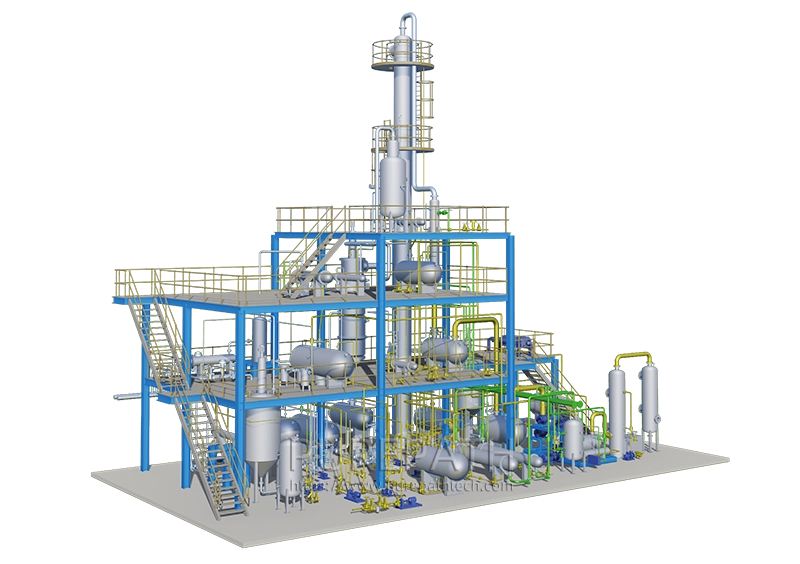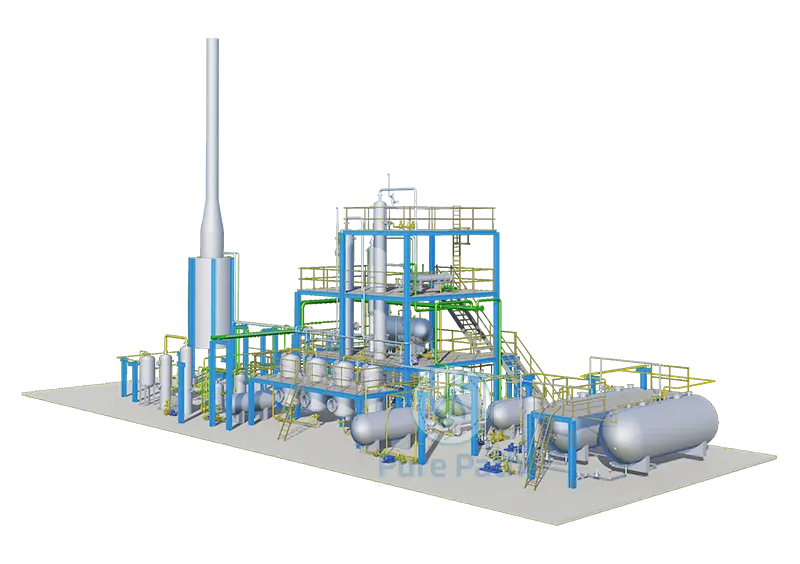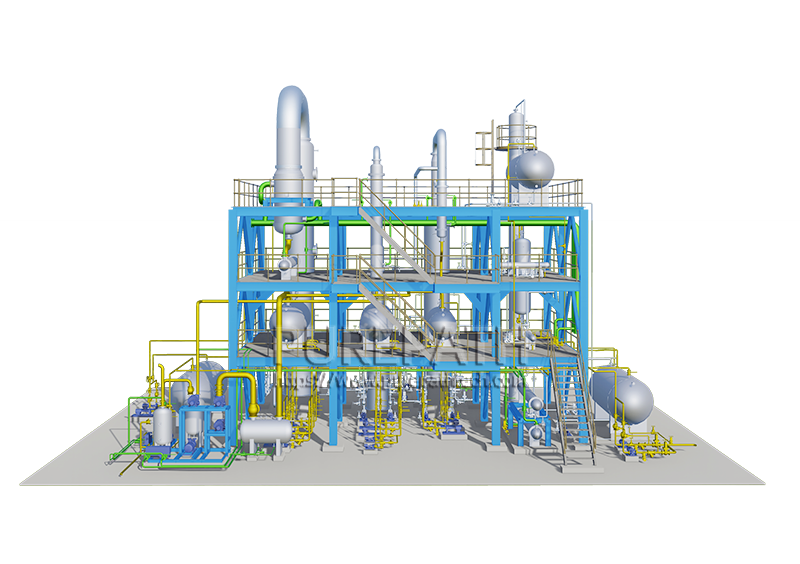Recycling of Used Motor Oil
The EPA estimates that there are 1 billion gal/y of used lubricants generated in the United States. Of this, 200 million gal/y are disposed of improperly. Additionally, it is believed that 40% of this material is poured directly into the ground [1]. These disposal methods not only pose a significant threat to local environments, but they also represent the waste of a valuable resource. In an effort to eliminate the future dumping of used lubricating oil, this report outlines the design and operation of a process to recycle 9.68 million gal/y of used automotive lubricating oil to a refined state.
Recycling used lubricants is not an altogether new idea. In the early 1960s, there were over 150 companies producing approximately 300 million gal/y of recycled lubricants. However, by the end of the decade, an explosion in drilling and refining technology pushed the costs associated with extracting and refining crude petroleum to all-time lows. While these technological innovations saturated global markets with inexpensive petrochemical products, the costs associated with re-refining used lubricants remained stagnant [1]. As a result, lubricating oil recycle facilities became increasingly inactive throughout the 1970s and have remained largely non-existent ever since.
In the last decade, American consumers have witnessed the political climate in the middle east continue to deteriorate, while diplomatic and economic relations with Central and South American oil producers remain tense. At the same time, the American public has taken an increasingly active interest in environmental protection policies. This interest has resulted in extensive federal legislation and increasingly vocal demands for more environmentally friendly products and practices. The synergistic effect of these two phenomena has created an environment in which the recycle of used lubricating oil is once again a socially desirable and economically profitable enterprise.
To return used automotive lubricating oil (hereafter referred to as motor oil) to its original composition, it is important to understand the chemical differences between used motor oil and new motor oil. Used motor oil can contain up to 71 wt% of the lube oil base stock, while the remaining 29 wt% is comprised of various contaminants [2]. Therefore, used motor oil can be re-refined to its original composition through a series of processes that separate environmental contaminants and products of degradation from the original oil base stock.
Motor oil becomes contaminated as a result of many physical and chemical interactions. Over time, zinc and other metals from engine components exposed to the motor oil can erode and enter the oil. High temperatures associated with lubricating the engine parts can cause the oxidation of hydrocarbon chains in the oil. The light hydrocarbons are generally volatile and do not significantly impede lubrication; however, the longer hydrocarbon chains made reactive by the oxidation reactions bond together to form sludge [3]. Used motor oil typically contains approximately 14 wt% sludge, which was modeled as the compound coronene in this design. Additionally, used motor oil is often contaminated by the presence of up to 5 wt% uncombusted gasoline that has leaked from faulty fuel injector lines [2]. In this design, the uncombusted gasoline was modeled as a mixture of four components which are shown in Table 1.
Table 1: Gasoline Components in Used Motor Oil
| Gasoline Components | Formula | MW | BP(°C) | wt % |
| Octane | C8H18 | 114.2 | 125 | 30 |
| Hexane | C6H14 | 86.2 | 68 | 50 |
| 2-Methylhexane | C7H16 | 100.2 | 90 | 10 |
| Ethanol | C2H5OH | 46.1 | 78 | 10 |
In order to improve engine performance, most new motor oils contain several additives including multiple sulfur-based detergents. These detergents keep material from depositing on the engine pistons but begin to break down as sludge accumulates in the motor oil [4]. The breakdown of these detergents typically results in used motor oil containing between 1 wt% and 3 wt% sulfur [5]. In this design, the collection of sulfur containing compounds in the used motor oil was modeled as thiophene.
Used motor oil is also characterized by a high concentration of polycyclic aromatic hydrocarbons (PAHs). In a study performed by Dominguez-Rosado and Pitchel [5], it was found that the PAH content of used motor oil is often between 34 and 190 times higher than new motor oil. In this design, the PAH mixture in used motor oil was modeled as equal weight percentages of five common PAH compounds which are shown in Table 2.
Table 2: PAH Components in Used Motor Oil
| PAH Components | Formula | MW | BP (°C) |
| naphthalene | C10H8 | 128.17 | 218 |
| acenaphthene | C12H10 | 145.21 | 279 |
| anthracene | C14H10 | 178.23 | 340 |
| pyrene | C16H10 | 202.25 | 404 |
| benz(a)anthracene | C18H12 | 228.29 | 438 |
The oil base stock used in this design was based on the boiling point distribution of straight chain alkanes corresponding to the boiling point distribution of new motor oil samples
[6]. The resulting hydrocarbon distribution (based on wt % of the oil base stock) is summarized in Table 3.
Table 3: Characterization of Lube Oil Base Stock
| Lube Oil Components | Formula | MW | BP (°C) | wt % |
| n-Octadecane | C18H38 | 254.5 | 317 | 3.69 |
| n-Nonadecane | C19H40 | 268.52 | 330 | 4.03 |
| n-Icosane | C20H42 | 282.55 | 342.7 | 4.76 |
| n-Heneicosane | C21H44 | 296.57 | 356.5 | 6.71 |
| n-docosane | C22H46 | 310.6 | 368.3 | 8.65 |
| n-tricosane | C23H48 | 324.63 | 379.9 | 10.06 |
| n-Tetracosane | C24H50 | 338.65 | 391 | 9.96 |
| n-pentacosane | C25H52 | 352.68 | 401.89 | 9.6 |
| n-hexacosane | C26H54 | 366.71 | 412 | 8.59 |
| n-Heptacosane | C27H56 | 380.73 | 422.1 | 8.25 |
| n-Octacosane | C28H58 | 394.78 | 431.61 | 8.14 |
| n-Nonacosane | C29H60 | 408.79 | 441 | 7.25 |
| n-Triacontane | C30H62 | 422.83 | 449.72 | 5.91 |
| n-Dotriacontane | C32H66 | 450.87 | 466.7 | 4.4 |
Finally, due to environmental and transportation factors, used motor oil often contains up to 10 wt% water [2]. The complete composition of the used motor oil feedstock to be re-refined is summarized in Table 4.
Table 4: Summarized Characterization of Used Motor Oil Feed
| Component | Mass (kg/h) | wt % |
| Sulfur | 52.5 | 1.4 |
| Gasoline | 175 | 4.65 |
| Water | 350 | 9.3 |
| PAHs | 490 | 13.02 |
| Sludge | 490 | 13.02 |
| Oil Base Stock | 2205 | 58.6 |
| Total | 3762.5 | – |
It should be noted that the characterization of the motor oil feed as defined in this process is intentionally conservative. This was done to account for discrepancies between different used motor oil sources. Additionally, it is important to understand that the chemical make-up of used motor oil is dependent on many factors that cannot be predicted with great accuracy. These factors, for a single unit of motor oil, include: the brand and composition of the new motor oil, the number of miles traveled between oil changes, the type of fuel used in the car, the age and state of the car’s engine and the location of the used motor oil storage (inside or outside, warm climate or cold climate, etc.).
Results
A process flow diagram of the proposed motor oil recycle process is shown in Figure 1. The equipment key corresponding to the process flow diagram is shown in Table 5.
Figure 1: Unit 100 PFD
Table 5: Unit 100 Equipment Description
| Equipment Name | Description |
| V-101 | Water/Organic Separator |
| V-102 | Sulfur Capture Knockout |
| H-101 | Fired Heater |
| TF-101 | Wiped Film Evaporator |
| R-101 | Hydrodesulfurization Reactor |
| T-101 | Light Fuel Tower |
| T-102 | Water Ethanol Tower |
| T-103 | Liquid-Liquid Extractor |
| T-104 | PAH/Solvent Recovery Tower |
| T-105 | Oil/Solvent Recovery Tower |
| T-106 | H2S Absorber |
| T-107 | Monoethanolamine Regenerator |
| E-101 | Light Fuel Preheater |
| E-102 | Light Fuel Condenser |
| E-103 | Light Fuel Reboiler |
| E-104 | Water/Ethanol Condenser |
| E-105 | Water/Ethanol Reboiler |
| E-106 | Wiped Film Evaporator Cooler |
| E-107 | Reactor Preheater |
| E-108 | Reactor Effluent Cooler |
| E-109 | PAH Tower Preheater |
| E-110 | Oil Tower Preheater |
| E-111 | PAH Tower Condenser |
| E-112 | PAH Tower Reboiler |
| E-113 | Oil Tower Condenser |
| E-114 | Oil Tower Reboiler |
| E-115 | Furfural Recycle Cooler |
| E-116 | H2S Interstage Cooler |
| E-117 | Monoethanolamine Regenerator Condenser |
| E-118 | Monoethanolamine Regenerator Reboiler |
| E-119 | Absorber Precooler |
| C-101 | Hydrogen Recycle Compressor |
| C-102 | Sulfur Treatment Compressor |
| P-101 | Reactor Feed Pump |
| P-102 | Furfural Recycle Pump |
| P-103 | Dowtherm Loop Pump |
References
1.Di-n-hexyl phthalate. (2010). Retrieved from http://www.chemicalbook.com/ChemicalProductProperty_EN_CB1256789.htm
2.Brinkman, Dennis W “Used oil: resource or pollutant?”. Technology Review. v88. 1985-07-01. p46(7).
3.Hazardous Materials: Facts about re-refined motor oil. Office of Sustainability and the Environment, City of Santa Monica. http://www.smgov.net/Departments/OSE/
Categories/Hazardous_Materials/Facts_About_Re-refined_Motor_Oil.aspx
4.Fedak, Don. “The Story of Why Engine Oil becomes Engine Sludge”. Engine Builder. 2001-09-01. http://www.enginebuildermag.com/Item/2389/the_story_of_why_engine_oil_ becomes_engine_sludge_.aspx
5.https://www.oronite.com/pdfs/Sulfonates_fnWeb.pdf
6.Dominguez-Rosado, Elena., Pitchel, John. “Chemical Characterization of Fresh, Used and Weathered Motor Oil via GC/MS, NMR and FTIR Techniques”. Proceedings of the Indiana Academy of Science. v112(2). 2003 p109-116.







